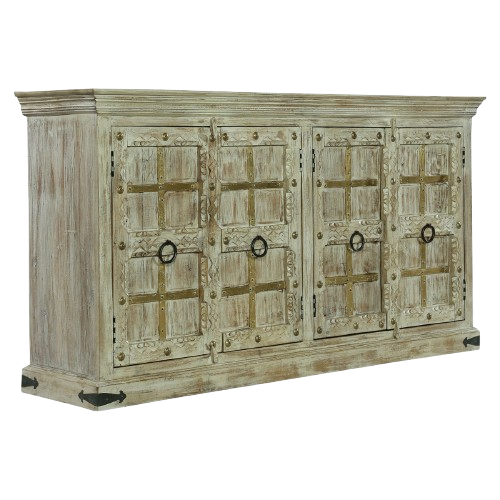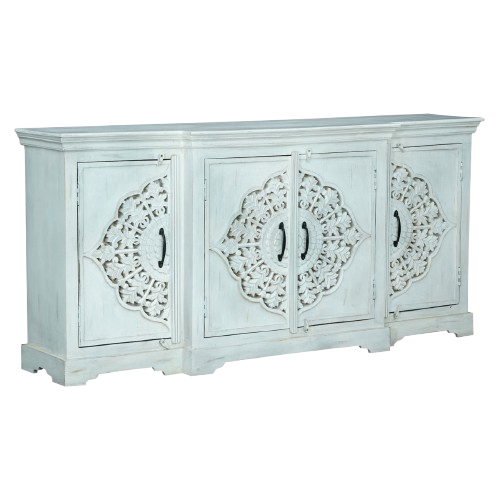Walk into any well-designed home, and you’ll likely spot a stylish piece of furniture that serves multiple purposes while looking effortlessly elegant. That piece is probably a sideboard—one of the most versatile and practical additions you can make to your living space.
A sideboard is much more than just another piece of furniture. It’s a multifunctional powerhouse that combines storage, style, and functionality in one sleek package. Whether you’re looking to organize your dining room essentials, display your favorite décor pieces, or simply add a sophisticated touch to any room, understanding what a sideboard is and how to use it can transform your home’s organization and aesthetic appeal.
From traditional dining rooms to modern living spaces, sideboards have evolved to meet the diverse needs of homeowners who value both form and function. They offer the perfect balance of practical storage solutions and decorative potential, making them an investment that works as hard as it looks good.
If you’ve ever wondered about the difference between sideboards and similar furniture pieces, or how to incorporate one into your home, you’re in the right place. Let’s explore everything you need to know about sideboard furniture and discover why it might be the missing piece your home has been waiting for.
If you’re looking for a variety of sideboards to suit your home, check out our sideboard collection for different styles and sizes.
What Is a Sideboard?
A sideboard is a low, wide piece of furniture typically featuring a flat top surface with storage compartments below. Originally designed for dining rooms, these versatile pieces have evolved to complement any space in your home. The defining characteristics of a sideboard include its horizontal orientation, substantial surface area for display or serving, and built-in storage through drawers, cabinets, or a combination of both.
Understanding the distinction between similar furniture pieces can help you make the right choice for your space. The buffet vs. sideboard debate often arises, but the terms are frequently used interchangeably. Traditionally, buffets were taller and narrower, designed specifically for serving food, while sideboards were longer and lower. A credenza, on the other hand, typically has no legs and sits directly on the floor, and is often used in office settings.
Modern sideboards come in various materials and finishes to match different design preferences. Wood remains the most popular choice, offering options from rich walnut and oak to painted finishes in contemporary colors. Metal accents, glass panels, and mixed materials create striking modern designs that fit seamlessly into contemporary homes.
The construction typically includes multiple storage options: deep drawers for linens and larger items, adjustable shelving behind cabinet doors, and sometimes wine storage or specialized compartments. This thoughtful design makes sideboards incredibly practical while maintaining their decorative appeal. Sideboards have evolved over time, but many wonder, do people still use sideboards today?
For families needing extra storage, our 4-door sideboards offer ample space while keeping your dining room organized and stylish.



What Is a Sideboard Used For?
Sideboard uses extend far beyond their traditional dining room origins, making them valuable additions to virtually any room in your home. The primary function revolves around storage, but the possibilities are extensive and adaptable to your specific needs.
Storage Solutions
In dining rooms, sideboards excel at organizing dishes, serving pieces, table linens, and glassware. The enclosed storage keeps items dust-free while remaining easily accessible during meals and entertaining. Living rooms benefit from sideboard storage solutions for organizing books, electronics, games, board games, and media accessories. Cable management features in modern designs help maintain a clean, organized appearance around entertainment areas.
Hallways and entryways transform with the addition of a sideboard, providing space for keys, mail, seasonal items, and everyday essentials. The surface area offers a convenient spot for a decorative bowl to catch loose items or a lamp to illuminate the space.
Decorative Display
The spacious top surface serves as an ideal platform for decorative elements. Family photos, artwork, vases with fresh flowers, or sculptural pieces create visual interest and personal touches. The horizontal expanse allows for layered arrangements that add depth and personality to your décor.
Functional Applications
During entertaining, sideboards shine as serving stations. The surface provides ample space for buffet-style meals, appetizer spreads, or beverage service. Some designs include built-in wine storage or specialized compartments for entertaining essentials.
The multifunctional nature extends to home offices, where sideboards can house office supplies, files, and equipment while providing workspace for projects or a printer station.
Sideboard Design and Styles
Sideboard design styles have evolved to accommodate diverse aesthetic preferences while maintaining the fundamental functionality that makes these pieces so appealing. Understanding different style options helps you select a piece that complements your existing décor and meets your specific needs.
Popular Style Categories
Modern and minimalist sideboards feature clean lines, smooth surfaces, and often incorporate mixed materials like wood and metal. These designs emphasize functionality with hidden storage solutions and sleek hardware that maintains the streamlined appearance.
Farmhouse and rustic styles bring warmth through natural wood finishes, visible grain patterns, and sometimes distressed details. These pieces often feature traditional hardware and may include elements like sliding barn doors or open shelving for displaying dishes or décor.
Mid-century modern designs showcase the iconic furniture movement with tapered legs, geometric shapes, and rich wood tones. These pieces often feature distinctive hardware and proportions that reflect the era’s design philosophy.
Size and Configuration Considerations
Sideboard furniture comes in various dimensions to accommodate different spaces and storage needs. Standard heights typically range from 30 to 36 inches, while lengths can vary from compact 48-inch pieces suitable for small spaces to expansive 72-inch or larger units for grand dining rooms.
Storage Configuration Options
The interior layout varies significantly between designs. Some feature primarily drawer storage, ideal for organizing smaller items and linens. Cabinet-style storage with adjustable shelving works well for larger items and varying heights. Combination designs offer both options, providing maximum flexibility for different storage needs.
Open shelving elements add visual interest and provide space for decorative display while maintaining easy access to frequently used items. If you love a warm, natural aesthetic, our rustic sideboards bring charm and character to any dining or living space.
How to Use a Sideboard in Your Home
Learning how to use a sideboard in the dining room and other spaces throughout your home maximizes both the functional and aesthetic benefits of this versatile furniture piece. Strategic placement and thoughtful styling transform a simple storage solution into a focal point that enhances your entire décor scheme.
Room-by-Room Applications
Dining rooms remain the most traditional location, where sideboards serve as command centers for meal service and storage. Position the piece along a wall where it won’t interfere with traffic flow around the dining table. The surface provides space for serving dishes during meals and decorative elements between entertainings.
A sideboard for living room use often serves as a media console or additional storage for a space that sees heavy daily use. Place it beneath a wall-mounted television or use it to define different areas within an open floor plan. The enclosed storage helps maintain a clean, organized appearance by hiding remote controls, gaming accessories, and other electronic items.
Styling and Decor Tips
The generous surface area invites creative styling approaches. Create visual balance by varying heights of decorative objects—perhaps a tall lamp on one end, medium-height vases or artwork in the center, and shorter decorative boxes or plants to complete the arrangement. This layered approach adds depth and interest to the display.
Mirrors placed above sideboards create the illusion of more space while reflecting light throughout the room. Artwork galleries or single statement pieces also work beautifully, depending on your style preferences and the room’s proportions.
Small Space Solutions
Compact sideboards work wonderfully in apartments and smaller homes, providing valuable storage without overwhelming the space. Look for designs with legs that create visual lightness, or choose pieces with lighter finishes that won’t dominate the room.
Choosing the Right Sideboard
Selecting the best sideboard for small spaces or larger rooms requires careful consideration of several key factors that will ensure your investment serves your needs while enhancing your home’s style and functionality.
Essential Considerations
Start by measuring your available space, including width, height, and depth. Remember to account for walking space around the piece and ensure doors and drawers can open fully without obstruction. Consider the room’s proportions—a sideboard that’s too small will look lost, while an oversized piece can overwhelm the space.
Storage needs should drive many of your decisions. Assess what you plan to store: do you need deep drawers for table linens, adjustable shelving for varying heights, or specialized storage for specific items? Your daily usage patterns will determine which features matter most.
Style compatibility ensures your new sideboard integrates seamlessly with existing furniture and décor. While matching exactly isn’t necessary, complementary finishes, proportions, and design elements create a cohesive look.
Practical Selection Tips
For multifunctional use, prioritize designs with versatile storage options and durable construction. Quality hardware ensures smooth operation of drawers and doors over time. Consider maintenance requirements—some finishes show fingerprints and dust more readily than others.
Sideboard furniture ideas for home decor should align with your lifestyle and entertaining habits. If you host frequently, prioritize surface area and easy access to stored items. For everyday organization, focus on storage solutions that match your specific needs.
Transform Your Home with the Perfect Sideboard
Sideboards represent the ideal marriage of form and function in home furniture. From their practical storage solutions to their decorative potential, these versatile pieces adapt to your changing needs while maintaining their essential role in creating organized, beautiful living spaces.
Whether you choose a modern design for your living room, a farmhouse style for your dining area, or a compact piece for a small apartment, the right sideboard becomes an integral part of your daily life. The combination of enclosed storage, display surface, and style flexibility makes sideboard furniture a smart investment that grows with your home and lifestyle.
Consider your space, storage needs, and style preferences as you explore sideboard options. With thoughtful selection and creative styling, your new sideboard will become both a practical storage solution and a beautiful focal point that enhances your home’s organization and aesthetic appeal for years to come.
Frequently Asked Questions About Sideboards
A sideboard is a versatile furniture piece typically used in dining rooms, living rooms, or hallways. It usually features cabinets, drawers, and sometimes open shelving to store dishes, cutlery, books, or decorative items.
While these pieces are similar, there are key differences:
– Sideboard: Focuses on storage and display, often shorter and wider.
– Buffet: Primarily used for serving food during meals.
– Credenza: Sleeker, often used in offices or modern living spaces for storage.
A sideboard can store dinnerware, linens, or tableware and act as a serving station during meals. You can also style its top with vases, artwork, or decorative trays to enhance your dining space.
Yes! Sideboards work great in living rooms as storage for books, electronics, or media equipment. They also serve as a stylish surface for décor like lamps, photo frames, or plants.
Popular styles include modern, minimalist, mid-century, farmhouse, and vintage. Each style offers different shapes, finishes, and storage options to suit your home decor.
Consider the following factors:
– Room size and layout
– Storage needs (drawers vs. cabinets)
– Style and finish that match your decor
– Multifunctional use in smaller spaces
Yes. Even without heavy storage use, sideboards can enhance your room aesthetically. Display artwork, candles, plants, or family photos to make it a stylish focal point.
Absolutely. Compact sideboards with slimmer profiles or multifunctional storage can fit into small living rooms, hallways, or dining areas without overwhelming the space.

